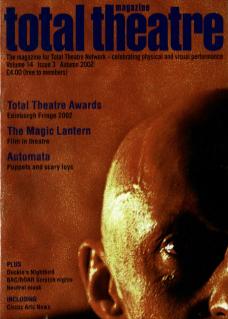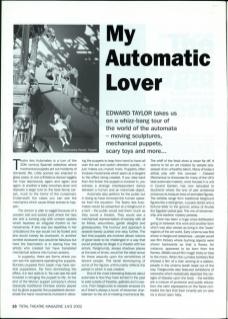Teatro des Automates is a turn of the 20th Century Spanish sideshow where mechanical puppets act out incidents of domestic life. Little scenes are enacted in glass cases. In one a flirtatious dancer wiggles her hips lasciviously again and again and again. In another a baby crouches down and deposits a large turd on the best family carpet, much to the horror of the nursemaid. Underneath the cases you can see the mechanics which cause these scenes to happen.
The dancer is able to wiggle because of a wooden ball and socket joint where her hips are and a turning cog with uneven spokes which bestows an irregular rhythm to her movements. If she was too repetitive in her undulations the eye would not be fooled and she would merely be clockwork. In another context clockwork toys would be fabulous but here the fascination is in seeing how the artists who created her have translated mechanical actions into human actions.
In puppetry, there are forms where you can see the operators operating the puppets. Bunraku puppets from Japan may have several puppeteers. Far from diminishing the effect, it in fact adds to it. You can see the skill involved in bringing the puppet to life. At the end of the Wuhan puppet company's shows (basically traditional Chinese stories played out by glove puppets) the puppeteers demonstrate the hand movements involved in allowing the puppets to leap from hand to hand all over the set and switch direction quickly – it just makes you marvel more. Puppetry often involves movements which seem at a tangent to the effect being created. If you step back from the fiction the puppet is involved in, you witness a strange interdependent dance between a human and an inanimate object.
Automata also perform for the public but in doing so have removed the human operator from the equation. The Teatro des Automates would be presented at a fairground in a tent – the public would visit them much as they would a theatre. They would see a mechanical representation of society with all its follies, absurdities, garish delights and grotesqueries. The humour and approach is seaside-bawdy pushed one step further. The fact that puppets are involved allows notions of good taste to be challenged in a way that would probably be illegal in a theatre with live actors. Fairgrounds, always shadowy places at the best of times, would be the ideal venue for these assaults upon the sensibilities of decent people. The racial stereotyping of some of the figures unfortunately reflects the period in which it was created.
One of the most interesting features about automata is how they have tended in the past to exist outside of theatres, galleries and museums. From fairgrounds to seaside emporia, it's as if there's always a touch of showman charlatanism to the art of creating mechanical life.
The whiff of the freak show is never far off. It seems to be an art created by people possessed of an unhealthy talent. Many of today's artists play with this concept – Cabaret Mechanical (a showcase for many of the UK's best automata makers), once housed in a unit in Covent Garden, has now relocated to Southend where the end of pier ambience enhances its treasure trove of animated figures. The exhibits range from traditional fairground figures like a strongman, a quack doctor and a fortune-teller, to the gnomic antics of Anubis the Egyptian jackal god. The mix of showmanship and esoteric mystery persists.
There has been a huge cross-fertilisation going on between this work and another form which was also viewed as living in the lower regions of the art world. Early cinema was first shown in fairground sideshows – people would see film trickery where burning objects were shown backwards so that a flower, for instance, appeared to be born from the flames. Méliès would film magic tricks or trips to the moon. When the Lumière brothers first showed a film of a train arriving at a station, people in the cinema booth leapt out of the way. Fairgrounds also featured exhibitions of waxworks which realistically depicted the ravages of disease upon the body – the exhibits are a mixture of prurience and public education; the calm expressions on the faces contradict the fact that their innards are on view via a sliced open belly.
Within the 'higher' regions of the art world, automata makers such as Eduard Bersudsky create miniature theatrical allegories which you sit and watch. (The Theatre Museum in Covent Garden is currently hosting the Sharmanka Kinetic Theatre exhibition of automata created by Bersudsky.) His creations mix religious themes with the carved figures of medieval carnival. The controversial American artist Paul McCarthy and his collaborators wear puppet Pinocchio masks (amongst others) to emphasise the de-humanising actions in his performances. We are dragged through a series of degrading actions performed by characters from our childhood. It takes the bad taste of the Teatro des Automates and pushes it into areas where subconscious desire meets crass mass commercialism. Ventriloquist's dolls often have licence to say the unsayable, often cruelly puncturing their owner's pretensions.
Automata can also be found on city streets. Medieval clocks would often open up to reveal the automated struggles between life, death, good and bad that time symbolises. In Newport town centre crowds gather in front of Andy Plant's mechanical clock just before the hour, waiting for it to spring into life. It has become a piece of street theatre.
The tall Roman columns that support the clock collapse, angels and devils vie for attention in a few vivid moments. He describes it as a white-knuckle clock, again emphasising that the fairground is never far away in being an inspiration for today's automata makers. Street theatre itself often uses puppets and mechanical creatures – Green Ginger's Gaston le Gouache is a puppet who draws you in the manner of a quick sketch artist; IOU Theatre created a show of giant tin toys called Autoperipatetikos (the original name for such inventions). It's a rich and varied area...
Cabaret Mechanical were commissioned by a shopping centre in Sheffield to make a huge journey, The Ride of Life – you sat on a sofa and were taken through various automated environments chronicling the passage between life and death. Hell was depicted as a miniature (f)unfair, Heaven was a choir of singing heads – in between you encountered a kitchen full of danger for the careless child, a theme park where history was condensed into its lowest common bland denominator and you were nearly run over by a full-sized animated lorry lurching towards you in the manner of Lumière's filmed train, amongst many other treats. Sadly its extraordinary mix of black humour, sarcasm and invention failed to impress the American backers and although the project was finished it was boxed up and left to rot in a warehouse. Luckily, parts of the exhibition were temporarily resurrected and shown at several museums where they busted all attendance records.
I went to see Monsters Inc. recently. I enjoyed it but the technique is terribly intimidating. It was only when I realised that a human hand still has to create each trembling hair on Sully the main monster's body (albeit via the finest computers that money can buy) that I felt a connection to it.
Despite the sophistication of modern computer animation there is still a fascination in watching little figures imitate life right there in front of you. The fact that you have to look in odd corners to discover where these figures might be performing adds to the magic of their discovery. The fact that the mechanics are there to see, whether it be a team of puppeteers or the turning of mechanical wheels, makes the magic even stronger – it makes it even harder to divine the skill of the makers.
Sharmanka Kinetic Theatre continues at the Theatre Museum Covent Garden until spring 2003. See www.theatremuseum.org


